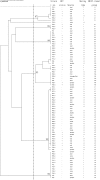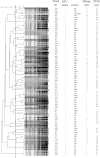Assessment of Candida glabrata strain relatedness by pulsed-field gel electrophoresis and multilocus sequence typing
- PMID: 17553975
- PMCID: PMC1951215
- DOI: 10.1128/JCM.00699-07
Assessment of Candida glabrata strain relatedness by pulsed-field gel electrophoresis and multilocus sequence typing
Abstract
In this study, 80 Candida glabrata isolates from intensive care unit and human immunodeficiency virus (HIV)-infected patients were typed by multilocus sequence typing (MLST), pulsed-field gel electrophoresis (PFGE), and mating type class determination. Among the 25 patients with multiple isolates, 19 patients (76%) contained multiple isolates exhibiting identical or highly related PFGE and MLST genotypes, which may indicate the maintenance or microvariation of one C. glabrata strain in each patient. However, isolates from six patients (24%) displayed different sequence types, PFGE genotypes, or mating type classes, which may indicate colonization with more than one clone over time or strain replacement. High correlations among PFGE genotypes, sequence types, and mating types were found (P < 0.01). MLST exhibited less discriminatory power than PFGE with BssHII. The genotypes, sequence types, and mating type classes were independent of anatomic sources, drug susceptibility, and HIV infection status.
Figures


Similar articles
-
Multilocus sequence typing for the analysis of clonality among Candida albicans strains from a neonatal intensive care unit.Med Mycol. 2014 Aug;52(6):653-8. doi: 10.1093/mmy/myu028. Med Mycol. 2014. PMID: 25037934
-
The molecular epidemiology of serial Candida tropicalis isolates from ICU patients as revealed by multilocus sequence typing and pulsed-field gel electrophoresis.Infect Genet Evol. 2009 Sep;9(5):912-20. doi: 10.1016/j.meegid.2009.06.011. Epub 2009 Jun 21. Infect Genet Evol. 2009. PMID: 19540937
-
A review of molecular techniques to type Candida glabrata isolates.Mycoses. 2010 Nov;53(6):463-7. doi: 10.1111/j.1439-0507.2009.01753.x. Mycoses. 2010. PMID: 19638001 Review.
-
Evaluation of Polymorphic Locus Sequence Typing for Candida glabrata Epidemiology.J Clin Microbiol. 2016 Apr;54(4):1042-50. doi: 10.1128/JCM.03106-15. Epub 2016 Feb 3. J Clin Microbiol. 2016. PMID: 26842706 Free PMC article.
-
Molecular diagnosis and epidemiology of fungal infections.Med Mycol. 1998;36 Suppl 1:249-57. Med Mycol. 1998. PMID: 9988514 Review.
Cited by
-
A single Ho-induced double-strand break at the MAT locus is lethal in Candida glabrata.PLoS Genet. 2020 Oct 15;16(10):e1008627. doi: 10.1371/journal.pgen.1008627. eCollection 2020 Oct. PLoS Genet. 2020. PMID: 33057400 Free PMC article.
-
Multilocus sequence typing of Candida tropicalis shows the presence of different clonal clusters and fluconazole susceptibility profiles in sequential isolates from candidemia patients in Sao Paulo, Brazil.J Clin Microbiol. 2013 Jan;51(1):268-77. doi: 10.1128/JCM.02366-12. Epub 2012 Nov 14. J Clin Microbiol. 2013. PMID: 23152555 Free PMC article.
-
Formation of new chromosomes as a virulence mechanism in yeast Candida glabrata.Proc Natl Acad Sci U S A. 2009 Feb 24;106(8):2688-93. doi: 10.1073/pnas.0809793106. Epub 2009 Feb 9. Proc Natl Acad Sci U S A. 2009. PMID: 19204294 Free PMC article.
-
Clonality, recombination, and hybridization in the plumbing-inhabiting human pathogen Fusarium keratoplasticum inferred from multilocus sequence typing.BMC Evol Biol. 2014 Apr 26;14:91. doi: 10.1186/1471-2148-14-91. BMC Evol Biol. 2014. PMID: 24766947 Free PMC article.
-
Genetic diversity assessed using PFGE, MLP and MLST in Candida spp. candidemia isolates obtained from a Brazilian hospital.Braz J Microbiol. 2021 Jun;52(2):503-516. doi: 10.1007/s42770-021-00446-x. Epub 2021 Feb 20. Braz J Microbiol. 2021. PMID: 33611738 Free PMC article.
References
-
- Al Aidan, A. W., W. Goessens, N. Lemmens-den Toom, M. Al Ahdal, and A. van Belkum. 2007. Microevolution in genomic short sequence repeats of Candida albicans in non-neutropenic patients. Yeast 24:155-160. - PubMed
Publication types
MeSH terms
Grants and funding
LinkOut - more resources
Full Text Sources
Medical

